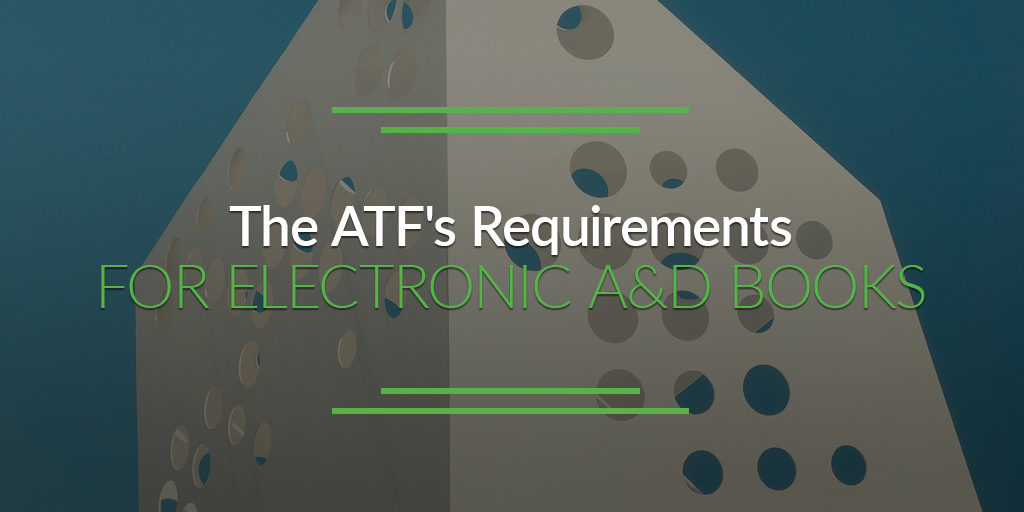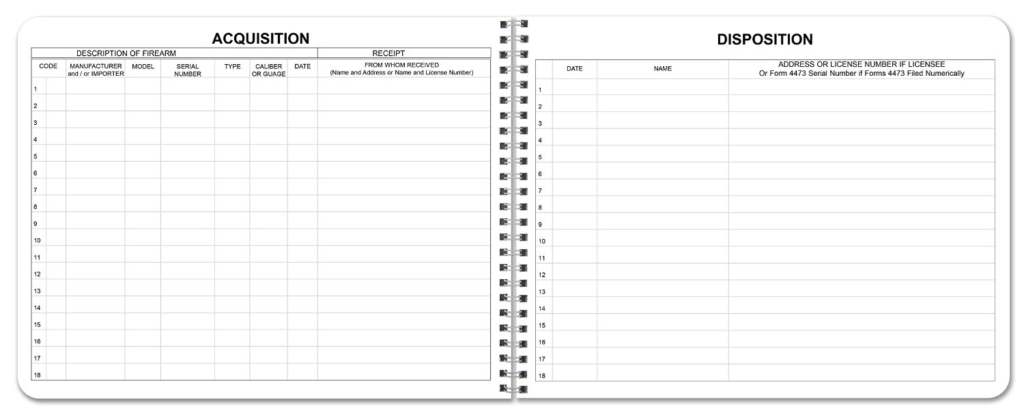
Now that the ATF permits electronic records of A&D books, it’s important to understand the regulatory changes and the new requirements.
The Gun Control Act of 1968 requires FFLs to keep and maintain acquisition and disposition records throughout course of business. The type of information an FFL needs to keep and the duration for which they need to keep it depends on the type of license. An importer must maintain different information than a standard dealer, for instance.
As a firearms dealer, you are expected to provide information to the ATF and other law enforcement officials in regards to the traceability of the firearms you sell. This means that you are required by law to provide information to police officers and special agents if they need to track the buyer of a gun in a criminal investigation.
Traditionally, dealers like yourself collect this information at the sale in an Acquisitions and Dispositions book (or “bound book” because of their signature spiral binding).

Image credit: Amazon.com
Your Acquisitions and Dispositions (A&D) book is the most important tool you have to stay in compliance with ATF regulations. Every single firearm you take in from manufacturers, vendors, private sales, trades, consignment, and gunsmithing should be recorded in the Acquisitions section. Any firearm you sell or trade should be records in the Dispositions section.
Your Acquisitions and Dispositions (A&D) book is the most important tool you have to stay in…
But like anything that’s kept on paper, this method presents a number of challenges. First, there’s a possibility of theft, loss, or destruction of the book. Unless you photocopy every page, it can’t be backed up. All it takes is a careless employee or leaky roof to ruin your compliance.
Second, simple mistakes are too common. If you failed to record all the digits of a serial number, you wouldn’t know until the ATF investigator pointed it out. Can’t read your handwriting? That’s a problem when law enforcement shows up to track a firearm.
The New Rulings
2016 brought significant changes to the ATF’s regulations. (The National Shooting Sports Foundation breaks them down nicely.) These changes strongly favor small businesses, because it gives FFLs more options in terms of their operations.
If you prefer the pen-and-paper bound book and physical forms, you can continue doing business as you please. Software, however, is undoubtedly the most effective way to modernize your business and improve efficiency.
Before these rulings, some use of electronic recordkeeping was permitted, but FFLs had to request a variance from the ATF’s Director of Industry Operations. These were not simple to obtain. Now FFLs can use electronic systems to ease some of the burden of the ATF’s requirements.
Here are the three rulings that have changed everything for A&D recordkeeping.
1. ATF Ruling 2016-1 Permits Electronic A&D Books
“The Bureau of Alcohol, Tobacco, Firearms and Explosives (ATF) authorizes an alternate method or procedure to the firearms acquisition and disposition recordkeeping requirements contained in Title 27, Code of Federal Regulations (CFR) 478.121, 478.122, 478.123, 478.125(e), 478.125(f), and 27 CFR 479.131. Specifically, ATF authorizes licensed importers, licensed manufacturers, licensed dealers, and licensed collectors to maintain their firearms acquisition and disposition records electronically instead of in paper format provided the conditions set forth in this ruling are met. This ruling supersedes ATF Rul. 2013-5, Requirements to Keep Firearms Acquisition and Disposition Records Electronically.” Read the full ruling.
This was a significant rule change. Essentially, it grants firearms dealers the ability to use contracted or leased servers to store their data, including cloud-based technology. For instance, when you use FastBound, we store your records in a safe, secure, regularly backed up data center. Our FFL customers don’t have to worry about storing their own records because we handle it.
This overrules Ruling 2013-5, which banned the use of cloud-based technology for A&D records. There are a few conditions, however.
- The A&D records must be readily accessible through a computer/device that is available on the business premises during regular hours.
- The servers with the records must be located within the United States.
- The ATF encourages FFLs to ensure there are strong security measures in place.
2. ATF Ruling 2016-2 Permits Electronic Forms 4473
“The Bureau of Alcohol, Tobacco, Firearms and Explosives (ATF) authorizes an alternate method or procedure from the provisions of Title 27, Code of Federal Regulations (CFR) 478.102(d), 478.121, 478.124, and 27 CFR 479.131 that require licensees to complete ATF Form 4473 (5300.9), Firearms Transaction Record, on a hard-copy and entering in the required information by hand. Specifically, ATF authorizes licensees to use an electronic version of Form 4473, instead of the paper format, provided the conditions set forth in this ruling are met. This ruling supersedes ATF Rul. 2008-3, Electronic Version of Form 4473.” Read the full ruling.
The first ruling gave us the ability to store our A&D records electronically, so it makes sense that the ATF would permit the use of electronic Forms 4473 as well. This form is required for every firearm sale, so they can pile up quickly. You can even accept electronic signatures, so you never actually need a paper form on site.
There are 22 requirements in the ruling that you are provided to obey, but they’re similar to the requirements of the ruling this supersedes (ATF Ruling 2008-3) for handling paper forms. You’re likely following them all anyway, but I recommend you read the full ruling to be sure. Our software, FastBound, is compliant already.
3. ATF Ruling 2016-3 Permits the Consolidation of Acquisition and Disposition Records
“The Bureau of Alcohol, Tobacco, Firearms and Explosives (ATF) authorizes an alternate method or procedure from the firearms acquisition and disposition recordkeeping requirements contained in Title 27, Code of Federal Regulations (CFR), 478.123. Specifically, ATF authorizes licensed manufacturers to consolidate their records of manufacture or other acquisition of firearms with their separate firearms disposition records, provided all of the conditions in this ruling are met. This ruling supersedes Ruling 2010-8, Consolidation of Records Required for Manufacturers.” Read the full ruling.
Before this ruling, the ATF required licensed manufacturers to keep records of manufacturing or acquisition of firearms separate from their records of dispositions to non-licensees. The new ruling allows for the consolidation of these records, but with a few requirements.
The most notable change relates to changes of firearm characteristics. If a licensed manufacturer makes an alteration to a gun (the mode, type, caliber/gauge, receiver, frame or assembly), they have to log the firearm out of their A&D book as a disposition (transfer) to themselves using their name and license number. This is so law enforcement can easily track a weapon if it was changed at some point.
Ammoland has a great breakdown of the other conditions.
Electronic A&D Bound Books
Using software for your A&D records significantly reduces the likelihood of a mistake. The task-oriented workflow asks for information in a calculated order so you collect everything you need and don’t fill out repetitive information (like the serial number of the firearm or the seller’s name), which saves time.
Just like your spiral bound books, software is required to collect the same information. Whenever there is an acquisition or transfer, you need:
- The model of the firearm
- The date you received it
- The date you transferred it
- The serial number
- The manufacturer or importer
- The number of Form 4473
- The type of firearm
- The gauge or caliber
- The name, company name, address, and FFL number of transferee
- The dispositions of any lost, destroyed, or stolen firearms
Some FFL’s attempt to make their own system with Excel, but that’s full of problems. Salesforce found that 88% of Excel files have human errors. Who knows if the creator built it properly? Furthermore, an Excel file won’t update when regulations change.
Whatever software you use must format your data according to all regulatory requirements for the required information. For instance, Form 4473 requires the use of “NMN” in the middle initial box if the buyer doesn’t have a middle name. Your electronic software must follow this format as well. It couldn’t just leave the box blank.
Your software must be self contained. If you use electronic records, no part of your process may be on paper. You could not, for example, record your acquisitions electronically and your dispositions manually. All parts of your system must be electronic.
The software must have the capacity to be queried by serial number and date (for fast lookups). It also must have a printing feature so any record can be made physical.
A Word of Warning
The ATF does not certify any electronic solution. Any program or provider that claims to be endorsed by the ATF is misrepresenting themselves. Software can be an invaluable tool to stay compliant, but you should take compliance seriously by understanding the regulations.
Do you prefer to keep manual records or do you use an electronic solution?
